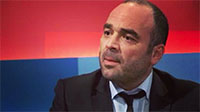
The tenacity of Yemen’s journalists in the face of danger
By Miki Mistrati
I’m feeling slightly anxious as the landing gear touches down on Yemeni soil. The risk of kidnapping keeps popping up in my head.
Yemen is among the most dangerous places in the world for journalists. Press freedom groups tell stories of the perils of Yemeni journalists on a near-daily basis and foreign journalists are under constant threat.
I’ve come to Yemen to teach investigative journalism to eight journalists at the request of International Media Support. I feel a need to give something back to those who risk their lives when doing journalism. That is exactly what Yemen’s journalists do.
My safety coordinator tells me two local journalists and a photographer from Al-Arabiya were attacked and beaten the day before I arrived. Six people were kidnapped last week, he says. It goes without saying that I’m not allowed to go outside during my stay. I try to hide my growing anxiety as we walk to the car that will take us through Sana’a where most of the kidnappings take place.
I look at the sky and see a few birds hovering. They’re not drones, I tell myself. Of course they’re not. A U.S. drone killed two suspected al-Qaeda members the day before I arrived. Daily life in Yemen is no doubt extremely challenging.
 About the author Miki Mistrati has worked with investigative journalism since 1996 and produced more than 40 documentaries for both Danish and international audiences. He has travelled and worked in 15 African countries, including Somalia, Mali, Angola, and Burkina Faso. He has received seven journalism awards, including the Danish Pulitzer prize equivalent, the Cavling Prize, in 2004. He currently works at the Danish daily Ekstra Bladet, where he heads the investigative journalism group, Gravergruppen, and produces the online documentary series SnapDocs. |
Our car takes us to a dilapidated, discreet building in a small side street. The house is beautifully decorated with handcrafted, pastel coloured stucco ceilings. I am greeted by the eight aspiring journalists, two of whom are women – no longer a rare sight in Arab and African journalism communities.
We get into it right away. I introduce the journalists to the basic ideas of investigative journalism through practical tools and personal experience. Before long, we take the first of what turns out to be several unplanned breaks. The electricity comes and goes, and we watch my investigative film on the dark side of the international chocolate industry in fragments. During the power cuts we get to deal with some of the ethical aspects of investigative journalism when the journalists ask critical questions about my methods: What were your thoughts on using a hidden camera? Why didn’t you blur the face of the slave trader?
Over the next couple of days I gain a thorough understanding of their talents for picking up important stories, some of which have great potential of becoming real investigative projects. Their controversial nature means they must remain confidential until they are published, and I ask myself what consequences they might lead to for the journalists when they are.
One of the younger participants mentions how he was unable to get a critical story published. Even giving it away for free didn’t work. “It’s too dangerous. Leave it,” editors told him. Others tell of stories that would surely get them killed if printed. Yemen is certainly a Mecca for investigative journalists, but a severely dangerous one.
Right now, the journalists need to transform their stories into actual investigative projects and have them published. In this process, they are putting their lives at risk. Simply by doing their job. One of the female participants is about to confront a government minister with his lies. This is possible in Europe, but will it work in Yemen? We’ll see.
Follow Miki Mistrati on Twitter: @MrMistrati




